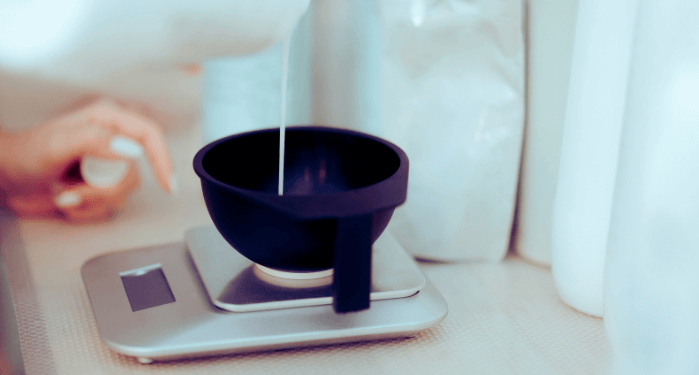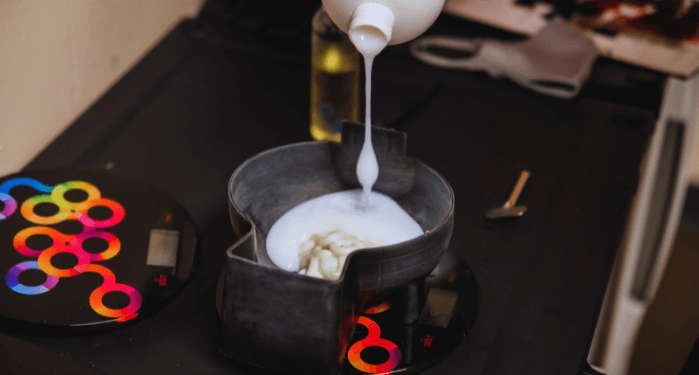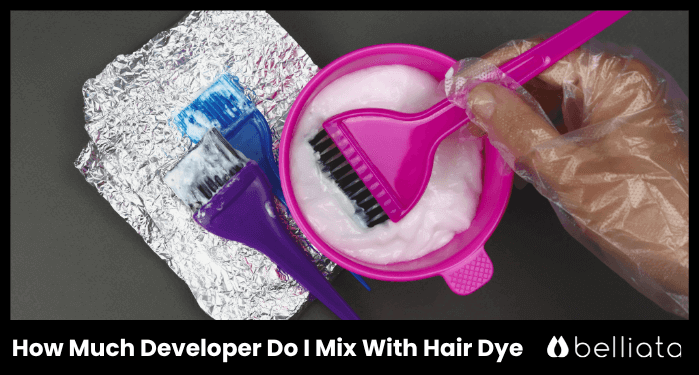How Much Developer Do I Mix With Hair Dye?
Posted on Sep 20, 2023
Knowing how much developer to mix with hair dye is an essential skill as too much or not enough dye can mean poor results and wasted product. So, how do the professional hairdressers do it? Let’s find out.
What You Will Learn
In this article, we’ll look at how to get the right proportion of hair dye and developer, tips on mixing hair color, and how to reduce or eliminate waste.
Jump to the Section You Like
What Is A Hair Developer?
A hair developer is an essential element in the hair coloring process. The oxidant creams contain hydrogen peroxide, which opens the hair cuticle. Color pigments, due to this process, can penetrate deep into the hair fiber and color it. Without the hair color developer you would never achieve significant changes in your hair color.
The hair color and the developer are mixed in proportion to form a tint mixture, which is then applied to the hair. The mixing ratio is usually 1:1, 1:1.5 or 1:2 (for an extra strong lightening effect).
How To Measure Hair Color And Developer?
There are a couple of different techniques that colorists will use to measure their dye and developer and trust me when I tell you that none of these involve guesswork.
If you don’t have the correct ratio, you can completely ruin a batch of hair coloring, or at the very least, you’ll end up with inconsistent results. Let’s take a look at some pro tips for measuring hair color.
Use Package Measurement Marks
People often wonder how to measure hair color from a tube, and sometimes it can be as easy as checking the tube (but not always).
Sometimes, getting your desired color is as easy as checking the packaging- this is often the case when clients select a straightforward color from your sample book.
Check the packaging- measurement marks should be easy to locate on your hair color tubes and will help you get the exact amounts each formula calls for. If you use the same brand every time, this is easy. If you’re working with different products, you’ll want to be extra careful here.
Of course, it never hurts to double-check before you start mixing- you don’t want to end up with too much hair dye and wasted product… which leads us to our next point.
Use a Scale
Whether you’re learning to measure 2 oz of hair developer or a seasoned pro creating complex mixtures in multiple shades, a simple kitchen scale is your best friend.
This is especially useful when your packages lack markings or you just want to be sure that you’ve got everything right- measuring weights will help you get the same amount, every time (remember how much clients love consistency).
When using your scale, reset it to zero after placing the empty bowl or container on it, then carefully record your weights for later use. After you’re done, transfer the contents to a mixing bowl and get started.

Use Measuring Cups
If you’re wondering how to measure hair dye without a scale, then you’ll need some measuring cups. Make sure that they’re plastic, not metal.
Before mixing, you can use a measuring cup to measure your color and developer. You can use two separate cups or a single one that you clean out between uses.
One thing to be careful of is how much hair color or developer gets left behind- make sure you scrape out every bit from your measuring cups into your mixing bowl when you’re done- you want to have the exact amount each formula calls for.

Do not miss our post on The Most Popular Hair Coloring Ideas.
Best Tips on Mixing Hair Dye and Developer Well
Pick The Right Dye For Your Hair
Do you have short hair or long hair? Do you have damaged, or previously colored hair? How much gray hair do you have?
Factors like hair length, hair texture and a client’s coloring history will all influence the hair color’s final result and impact the formula you select. The amount of dye and developer that you need will depend on the length of your client’s hair- you may need two boxes or tubes of dye for the longest hair, so make sure to factor that into your service costs, too.
Select the Right Tools
Since metal can cause the hair dye to oxidize, make sure to use a bowl that’s made of plastic, silicone or glass for mixing.
The same goes for your tools- use plastic utensils or silicone whisks to blend everything together- even plastic forks will do in a pinch, but a whisk works best for a smooth blend. A plastic fork will work in a pinch.
And never use your color brushes for mixing. Hair developers or lightening powder can easily get stuck in the bristles and yield inconsistent or clumpy results.
Choose Your Developer and Hair Color Carefully
Not all developers are created equal, and there may be situations where you’ll want to use a cream developer or opt for hydrogen peroxide, so it’s important to be familiar with the developer ratio for each and how they behave when mixing.
Pour Slowly
When measuring how much developer to mix with hair color, take your time. You can always put in more, but it’s nearly impossible to put it back in the bottle once it’s out.
This is especially true if you’re using lightning powder or a clear developer since those can pour quickly- you don’t want to overdo it accidentally. Pour out a quarter of what you need, checking the measurements. You can always add more dye later.

Make Sure to Choose the Right Strength
Unlike box dyes, professional hair color developers come in different strengths (also called “volumes”). These range from level 10 to 40, with 40 being the strongest.
While you may want to use a gentler level on things like root touch-ups or small discolorations (level 20 works well for lifting color two shades or so), level 40 is best for high lift colors like bright blonde shades (it can brighten hair four shades or more, so use it carefully).
Be Aware of Sensitivities
Peroxide can be irritating, so you may want to stick with cream developers if your client has a sensitive scalp. Ask about any previous reactions to the developer or dye before you begin.
More information in our post Balayage Hair Color Trends.
Hair Color To Developer Proportion Ratios

So, what does hair developer do by itself, and why do we use it?
Developers such as hydrogen peroxide help to open up hair cuticles and let color penetrate the hair shaft. Using enough developer also helps to open up the hair cuticle and lift the natural color out, allowing permanent hair dye to show up brighter.
Using a hair developer helps you achieve consistent and lasting changes, but using too much developer can negatively affect results.
Since not all hair dyes contain the same amounts or have the same requirements, knowing how much developer to add when mixing dye can be challenging. You may want to keep a hair color mixing ratio chart handy in the back room for easy reference.
So, how much hair dye and how much developer will you need?
Let’s take a look at the common mixing ratios and what they’re used for:
1:1 Ratio - Hair Color to Developer
If you’re coloring hair a single shade that’s close to the natural color, use a 1:1 ratio- these equal proportions will be just enough to help hair colors easily stick to the shaft.
This is also the usual color to developer ratio for gray hair, but if you’re having trouble trying to dye stubborn grays, I’d recommend switching to a 1:1.5 ratio or adding a longer processing time.
1:1.5 Ratio - Hair Color to Developer
If you’re applying a toner or lightening a client’s hair by one or two levels, this ratio will be enough to achieve good results. This also works well on the grown out part of a client’s hair if you’re trying to dye stubborn roots.
1:2 Ratio - Hair Color to Developer
This mixture works best when you want to achieve dramatic results and go three or four shades lighter in color. To do this, you’ll also need to use a 30 or 40 volume hair developer. Be careful and make sure that the hair isn’t brittle or damaged, or you’ll just make things worse.
When mixing your formula, how much hydrogen peroxide or cream is too much? Keep in mind that hair developer levels can go too high, as well as two low. If you use too much developer, the hair colors won’t penetrate properly and will look faded or washed out.
Conclusion
Hair dye is a great way to quickly change or refresh your hair color, and the results can be subtle, glamorous or downright dramatic.
When learning how to measure hair color and developer, consistency is the most important thing to remember. Always go through the same steps in your measuring and mixing process to avoid mistakes, and take notes so that next time you do it you’ll know what works well and what doesn’t.

Ann
Ann, a writer with a keen eye for hair and beauty trends, loves translating the latest styles into engaging content. Her expertise spans across both hair and beauty, allowing her to craft informative pieces on everything from chic haircuts to flawless makeup looks. When not writing, Ann keeps her finger on the pulse of the industry by following fashion shows and scouring social media for the hottest trends.

